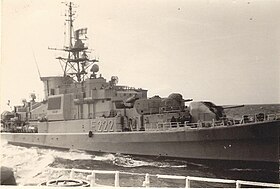Augsburg (F 222)
|
|
|
|---|---|
| Augsburg (F 222) | |
| Cologne class | |
 Frigate Augsburg (F 222) in 1971 |
|
| Overview | |
| Shipyard |
HC Stülcken son ; Construction no. 883 |
| Keel laying | October 29, 1958 |
| Launch | 15th August 1959 |
| Namesake | City of Augsburg |
| Commissioning | April 7, 1962 |
| Decommissioning | March 30, 1988 |
| home port | Wilhelmshaven |
| Whereabouts | scrapped in Hamburg |
| Technical specifications | |
| See: Main page of the class | |
| Callsign / identifier |
DRAM / F 222 |
| Insinuation | |
The Augsburg was a frigate of the German Navy and the third unit of the F120 class (Cologne class). In a German navy, she was the second ship named after Augsburg , the capital of Swabia (Bavaria) . The predecessor in its name was the small cruiser SMS Augsburg .
technology
The keel was laid on October 29, 1958 in Hamburg. When it was launched, Klaus Müller , the Lord Mayor of Augsburg, gave the baptismal speech and his wife Anny Müller named the ship Augsburg . When it was commissioned on April 7, 1962, the escort boat was assigned to the 2nd escort squadron in Cuxhaven.
Since it was mainly designed for use in the Baltic Sea, the emphasis in the Cologne class was on speed and powerful anti-aircraft armament and less on driving range and seaworthiness. The frigates of the Cologne class had a low smooth deck and high superstructures. The automatic 100 mm guns from France were set up in a turret each on the forecastle and the stern. Twin guns of 40 mm caliber were in positions B and E and a 40 mm gun in single mounts on either side of the aft superstructure. The two Bofors anti-U rocket launchers stood next to each other between the front 40 mm gun and the open bridge . On both sides of the bridge there were unmistakable air intake ducts for the gas turbines , the large chimney with its strikingly enlarged cap and side-mounted transmitting and receiving antennas made the class easily recognizable. The CODAG machine system consisted of four diesel engines and two gas turbines, which were coupled to both shafts , as well as controllable pitch propellers .
history
The Augsburg took part during their service at many maneuvers and exercises in the North and Baltic Seas, Atlantic, Mediterranean and many trips abroad. Special missions included taking part in the celebrations for the 75th anniversary of the takeover of Heligoland by the German Empire on August 10, 1965 and, together with the frigate Braunschweig and the destroyer Bavaria, taking part in the fleet parade in Portsmouth for the 20th anniversary of the NATO in front of the British Queen Elisabeth and the Duke of Edinburgh on May 16, 1969. During the state visit of King Olafs V of Norway on June 8, 1973, the Augsburg was the fleet flagship at the official farewell in Kiel.
On January 12, 1967, the Augsburg was taken out of service for the purpose of conversion. It was returned to service on January 7, 1969.
On the night of May 9, 1975, there was a collision with the Polish ship Profesor Bohdanowicz in the Skagerrak . Serious damage occurred and four were injured. An emergency repair was carried out on May 10 and 11, 1975 in Grimstad, Norway. The subsequent repairs in Germany lasted from October 1, 1975 to October 11, 1976. On January 18, 1982 there was another collision, this time with the British fleet supplier Tidespring during a maneuver. In the base of Wilhelmshaven at the pier lying the ship was hit by an incoming Soviet tractors on October 1, 1985th There was about 630,000 DM damage.
After a NATO maneuver, on September 8, 1986, a shipyard lay in the Lloyd Werft Bremerhaven . All machines have been overhauled. Most of the superstructures have been repaired. New decks were welded in, which were supposed to provide more structural strength, especially in the vulnerable middle section. The underwater hull was completely blasted and electronics (teleprinter, radios) installed. Estimates put the costs at around DM 30 million. In January the ship was supposed to go on maneuvers to West Africa for three months. After the shipyard test drive, the Augsburg was classified as no longer suitable for the Atlantic (after consultation of the shipyard with the Ministry of Defense). Instead, she was assigned to participate in the DESEX 1/87 maneuver.
At the end of March 1987, one of the last Augsburg missions was an official visit to Den Helder . From October 1, 1987, the ship was out of service and was decommissioned on August 30, 1988. Then it was a trailer in the Naval Arsenal in Wilhelmshaven and was advertised for sale. The ship was sold for demolition via Vebeg , towed to Hamburg on November 17, 1989, and broken up there in December.
swell
- The frigates of the “Cologne” class. In: Frigate “Augsburg” - F 222 - on-board community of Augsburg drivers. Retrieved November 4, 2012 .
